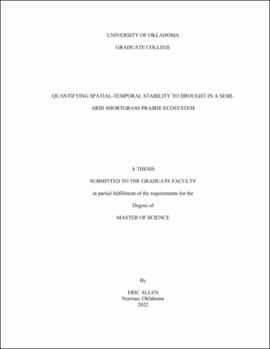| dc.description.abstract | Drought is known to cause negative ecological impacts in grasslands, with areas prone to drought expected to experience increases in both severity and frequency in the coming years. Cimarron County, Oklahoma is located at the westernmost extent of the Oklahoma panhandle and has a history of intense drought events, including those of the Dust Bowl era. Since 2005, there have been repeated droughts in the county, including a single event lasting from 2011-2015. We analyzed remote sensing data to understand the spatial and temporal stability of grassland structure (Enhanced Vegetation Index) and function (Gross Primary Productivity) within Cimarron County with reference to drought. Drought was quantified using the Standardized Precipitation Index, derived from a remotely sensed precipitation dataset. Stability was quantified by applying the BFAST (Breaks for Additive Season and Trend) algorithm to determine structural breaks within each metric’s time series, and by calculating the coefficient of variation for each pixel across the county. Temporal data show that while these grasslands display characteristics of low stability at the onset of drought, they exhibit consistent positive trends in EVI and GPP following each drought event, recovering, and sometimes eclipsing their pre-drought levels. Spatial data indicate high spatial heterogeneity in EVI and GPP variability across the county, and a relatively low but significant correlation with drought variability. These analyses suggest while drought has a significant effect on grassland stability, there are likely many other drivers, and while the onset of drought greatly effects grassland structure and function, they are consistently able to rebound and regain their pre-drought levels. Although these grasslands are impacted by drought, their ability to recover is rapid. Likely, plant composition or drought events are taking place during times of dormancy and mediating these responses, when plants may be less affected. | en_US |
